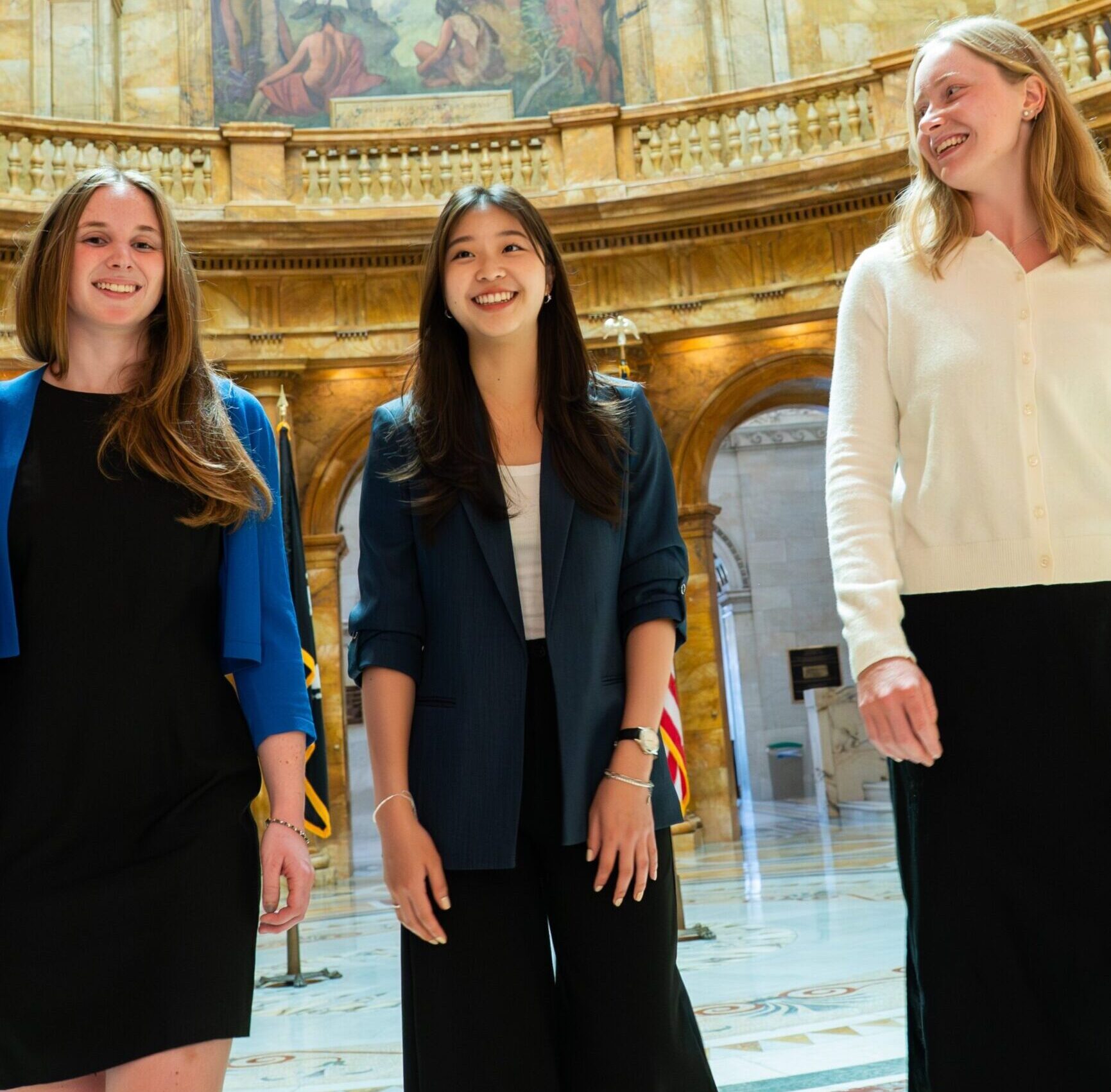4 Harvard climate experts on Trump and what’s next
On a May 14 panel, Harvard climate faculty shared what they have learned from the first four months of the Trump administration, what worries them the most about his attacks on climate research and policy, and what they are watching in the months ahead.
The four professors – a scientist, an economist, a legal scholar, and a lung doctor studying the health effects of climate change – each bring a different professional perspective, but agree on much.
Here we reprint lightly edited versions of their opening remarks.
- Joe Aldy – Creating uncertainty and halting progress
- Jody Freeman – The five pillars of U.S. climate policy, and how each is threatened
- John Holdren – Damage from cuts to U.S. climate science
- Mary Rice – When science is silenced, lives are lost
- Further reading
A recording of the conversation may be viewed here.
Creating uncertainty and halting progress
Joe Aldy, Teresa and John Heinz Professor of the Practice of Environmental Policy, Harvard Kennedy School, Former Special Assistant to the President for Energy and Environment
In assessing the first four months of the Trump administration’s actions and policies on climate change – and their likely implications – I would emphasize four key points.
Policy uncertainty
The most defining feature so far isn’t a policy direction, but policy uncertainty. That ambiguity has a chilling effect on private-sector investment and long-term planning.
From tariffs to tax debates in Congress, regulatory rollbacks, and changes in permitting processes, the lack of clarity is raising the cost of investment and slowing the deployment of new energy technologies. That leads to less investment and potentially higher prices – not just for clean energy, but for oil and gas as well.
Tariffs have directly raised costs on key inputs like steel used in drilling. Indirectly, they contribute to a weaker economic outlook and lower oil prices; prices are down about 25 percent since Trump took office. This is not due to successful policy, but to weaker demand expectations. Altogether, we’re likely to see declining investment across the energy sector.
Dumping diplomatic tools
This administration’s approach to engaging other countries can be best be described as unilateralism. From day one, walking away from the 2015 Paris Agreement and skipping major global forums like the G20, the U.S. has disengaged. As a strategy for advancing U.S. interests, however you define them, I find that quite puzzling. Even fossil fuel states like Russia and Saudi Arabia stay engaged with UN climate talks to protect their interests. It’s hard to represent yours if you’re not in the room.
When strategically deployed, U.S. soft power helps shape favorable outcomes on global energy and climate issues. Unilaterally throwing away some of the key tools of international relations doesn’t make it any easier for the U.S. government to achieve its goals.
Low information, high risk
The administration appears committed to being a low-information government, cutting the collection and sharing of critical data. This hampers our ability to understand climate risks, weakening the tools people and businesses depend on to prepare for natural disasters.
This is important both for improving public health, but also to key market functions. A lot of what we see, for example in insurance markets, draws on data that have originally been collected and organized and analyzed by the U.S. government and by scientists supported by the government.
We already know that with an increasing array of natural disaster risks, the price of insurance – basically the cost of living – is increasing significantly in places like California and the Gulf States. If we have less information for insurers to feed their models, we’re going to see some companies leave areas they think are high risk. Because they don’t have the evidence to assess and identify those risks, insurance premiums will increase even more.
Policymaking is hard work
Effective policymaking requires skilled public servants trained in science, law, economics, engineering, and health.
As we have seen, the gutting of the federal workforce means these dedicated public servants aren’t there to do their work on behalf of the American public. Whether the goal is to advance decarbonization or energy dominance, to make progress and be effective you need a talented civil service. If you’re goal is to simply stop doing work on behalf of the American public, then gutting the federal workforce would be fine. But any affirmative goal – whether it’s advancing decarbonization or energy dominance – depends on the talent of the civil service.
The five pillars of U.S. climate policy, and how each is threatened
Jody Freeman, Archibald Cox Professor of Law; Director, Environmental and Energy Law Program; Harvard Law School; Former White House Counselor for Energy and Climate Change
For me, there are five pillars in how we approach climate policy in the United States. Donald Trump is attacking all five.
1. International engagement
The U.S. plays a crucial role in global climate negotiations. Our presence – or absence – on the international stage influences cooperation on emissions reductions, technology transfers, and adaptation financing. Abrupt shifts in policy weaken trust and disrupt progress. The president has announced that the U.S. will withdraw from the Paris Agreement.
2. Domestic regulation
The president is challenging federal and state environmental and clean energy rules in a variety of ways, including with executive orders. In April, Trump directed the Attorney General to investigate state-level clean energy policies, with the goal of undermining any perceived threat to the administration’s commitment to fossil-fuel dominance.
At the same time, the administration instructed agencies like the Federal Energy Regulatory Commission (FERC) to deploy emergency powers to prop up coal-fired power. The president also signed orders directing agencies to roll back environmental rules without the usual public notice or comment process. That threatens the bedrock principle of transparent, lawful government.
Another example of the administration’s attack on state-level regulation is the battle over California’s Clean Air Act waivers. That special authority granted to the state by Congress allows California to apply to EPA for a “waiver” of federal preemption to set its own vehicle emissions standards, which other states may follow. California’s role is important nationwide because the state has been a bulwark against federal backsliding, by continuing to spur progress toward cleaner technologies in the transportation sector even when federal rules are weakened. Now, Congress appears poised to nullify the most recent waivers, using a law that allows it to void federal rules using a fast-track, filibuster-proof process. Although these individualized waiver grants have never been treated as rules before, Congress is considering classifying them as rules now, over the objection of both the General Accountability Office and the Senate Parliamentarian. The House has already voted to disapprove them; the Senate’s decision to do so would set a far-reaching precedent.
3. Industrial policy
When Congress invests in clean energy infrastructure, transportation, and manufacturing, as it did by passing the Inflation Reduction Act and the Infrastructure Investment and Jobs Act during the Biden administration, it’s pursuing an industrial policy approach to climate change. The Greenhouse Gas Reduction Fund, for instance, was designed to inject billions into decarbonization and efficiency upgrades, such as clean school buses and more efficient buildings. Yet, early on, the Trump administration froze much of this funding, even though it was congressionally appropriated and fully obligated to grantees. Judges have intervened to unfreeze some grants, but the broader landscape remains mixed as challenges move through the courts. The current uncertainty and instability is bound to have a chilling effect on grantees and their private-sector partners, and will undermine confidence in government-backed climate efforts.
4. Climate science and research
The administration has also taken aim at the scientific research behind climate policy. One major example is the pending reconsideration of the Endangerment Finding – the scientific and legal basis for regulating greenhouse gases under the Clean Air Act. If the administration were to rescind the endangerment finding, there would no longer be a legal foundation to set federal greenhouse gas standards. This would remove the government’s most important tool for limiting climate pollution.
5. The role of the private sector
Finally, the private sector is essential to driving clean energy innovation and addressing climate risk. And it too depends on regulatory consistency and predictability from government. Abrupt funding freezes, shifting rules, and chaotic policy gyrations have sown uncertainty and undermined confidence, which inhibits investment and innovation across energy, transportation, and tech. The administration has also threatened private sector climate coalitions with anti-trust investigations, chilling private sector coordination to promote net-zero commitments.
What’s reversible?
Many people ask me whether these rollbacks and reinterpretations are permanent. Executive orders are not law. The normal rule is: What a president can do with the stroke of the pen, the next president can undo with the stroke of the pen. But that’s not exactly right in this instance because of the extent to which this administration is changing the status quo with utter disregard for the normal legal constraints. The administration is swinging for the fences and clearly daring the courts to stop them. And by the time the law catches up with them, conditions on the grounds will have significantly shifted. Re-building government capacity is harder than tearing it down. Attracting new private investment is harder than scaring it off. So reversing some things will be much harder.
More broadly, the administration is doing lasting harm to the government’s institutional capacity and to democratic accountability. When you don’t have access to science and information; when long-serving independent experts are cut out of government policymaking and replaced by loyalists; when expertise is downgraded, and political support or affiliation is upgraded within the agencies; when you can’t access the data necessary to assess whether public health outcomes are worse or better – when all these things happen, it becomes harder to hold the government to account.
Damage from cuts to U.S. climate science
John Holdren, Research Professor at Harvard Kennedy School; Former Professor of Environmental Science and Policy in the Department of Earth and Planetary Sciences; Co-Director of the Science, Technology, and Public Policy Program at the Belfer Center for Science and International Affairs; Former Director of the White House Office of Science and Technology Policy
The only two global dangers that compare to climate change in magnitude are nuclear weapons and pandemic disease. Human-caused disruption of the global climate is already harming economies, ecosystems, human health and safety, and international security (as long recognized by the Pentagon).
But Trump is heedlessly savaging the United States’ capacity to understand and respond to the climate menace, slashing budgets and staff and eliminating programs right and left in what had been one of the world’s two most comprehensive efforts to address the climate challenge, alongside China’s.
Trump’s cuts are not only devastating U.S. climate research and policy engagement inside the federal government. The cuts are also disrupting climate-science, technology-development, and education efforts that depend on federal funding at colleges, universities, state and local governments, NGOs, and businesses across the country.
Let me drill into a few examples of the damage the administration is doing:
- The National Oceanic and Atmospheric Administration (NOAA) is the most important center of climate-change research, monitoring, and education in the federal government. Early in the administration, the Trump-Musk team dismissed more than 10 percent of NOAA staff, started cutting back its climate-monitoring and database operations, and announced the intention to dismantle NOAA’s research office – one of the world’s most important producers and funders of climate science. Trump’s budget for fiscal year 2026 would indeed dismantle that office, if approved by Congress, as well as hobble early warning systems for natural disasters and demolish climate-science education for students in kindergarten through high school.
- NASA’s earth science programs are a major source of satellite- and aircraft-based observations of the planet’s land and vegetation, oceans, and ice – information essential to tracking climate-change impacts and designing adaptation strategies, among many other uses. Having fired NASA’s chief scientist and her staff in March, Trump’s 2026 budget calls for a 50 percent cut to NASA’s Earth Science division.
- The 15-agency U.S. Global Change Research Program coordinates federal government efforts on global-change research, most importantly on climate change. At the end of April, the Trump administration terminated the consortium’s quadrennial assessment of climate-change impacts on the United States in midstream. The assessments, mandated by Congress and previously produced in every administration since Clinton’s, focus on disaggregating climate-change impacts by region and by sector. They’ve provided indispensable guidance to states, communities, and businesses on specific needs for climate-change adaptation.
The costs of this destruction will be high. They’ll include slower progress in understanding the pace of climate-change impacts and the distribution of those impacts across regions and sectors– essential for crafting adaptation strategies. The costs will also include reduced advanced warning of climate-linked extremes (dangerous heat waves, powerful storms, extreme flooding, and so on), meaning less time for evasive action.
When science is silenced, lives are lost
Mary Rice, Mark and Catherine Winkler Associate Professor of Environmental Respiratory Health; Director, Center for Climate Health and the Global Environment; Harvard T.H. Chan School of Public Health
Among the many rollbacks we’ve seen under the Trump administration, one of particular concern, because of the far-reaching health consequences, is the downsizing of the EPA’s main science division, the Office of Research and Development. The ORD employs approximately 1,500 research professionals whose work underpins environmental health protections – including air quality and climate policy – for the entire country.
The ORD plays a critical role in studying how people are exposed to climate-driven hazards like extreme heat and air pollutants – like ozone smog and wildfire smoke – and how those exposures affect the heart, lungs, and brain. The human exposure studies and the synthesis of all the best available research by the science branch provides the EPA policy branch the evidence needed to set health-based air-quality standards and greenhouse-gas emissions policies to protect public health with an adequate margin of safety. Historically, these health-based policies for clean air have yielded enormous health benefits: more than $10 for every $1 spent, due to improved life expectancy, avoided heart attacks and asthma attacks, among other benefits.
Almost all the climate-related rules that are at risk of being undone (motor vehicle emissions standards, rules on greenhouse-gas emissions, and mercury and other airborne toxins from power plants) are based on an assessment of the harm to human health.
Gutting the core scientific capacity of our federal government to protect public health from pollution and climate change leaves decisions more vulnerable to political pressure and less grounded in science – putting public health at serious risk.
Second, I am concerned about the sweeping cancellation, freezing and uncertainty around federal funding for climate and health research and community-led climate health programs.
Billions of dollars of EPA funding distributed to low-income communities under the Inflation Reduction Act to improve their resilience against the health effects of climate change and air pollution is now canceled or frozen. Initiatives disrupted include wildfire smoke protection in the western U.S., air purifier distribution in low-income areas, and urban programs to reduce health risks from extreme heat and pollution.
In just the past few days, the EPA has cancelled hundreds of research grants to universities: Almost the entire EPA extramural health research portfolio has been cancelled. One of these studies, led by our C-CHANGE deputy director at the Harvard School of Public Health, Amruta Nori-Sarma, developed interactive dashboards for communities to visualize overlapping health risks from heat, air pollution, flooding, and chemicals. That work is now halted: focus groups unfinished, trainees suddenly unfunded, and years of trust with local community partners at risk.
At the National Institutes of Health, the future of funding for climate and health research is uncertain. There appears to be a shift to focus on short-term disasters like wildfires and heatwaves without considering underlying climate drivers. This change may sideline vital research on the full scope of health consequences of greenhouse-gas emissions and reductions that could save lives.
With climate and environmental health research shutting down at EPA and at universities nationwide due to funding cuts, our ability to evaluate emerging health threats – including wildfire smoke toxicity and new infectious disease threats – will be severely compromised. Shutting down this research undermines our ability, as a society, to protect the health of Americans of all ages – and when science is silenced, lives are lost.
Further Reading
Trump’s impact on climate is a topic we have covered from many angles over the past few months:
Experts see a ‘low information’ reversal of U.S. climate leadership
Salata panelists warn of lasting damage from executive orders and cuts to research funding. By the Harvard Gazette.
Breathe easier? Not without the science
By canceling a multi-year study of older people with lung disease – a few months before it was due to end – the Trump administration has left patients without help, doctors without answers, and wasted taxpayer dollars. By Mary B. Rice.
The 2025 Tax Debate and Clean Energy Investment
An economist surveys the potential fiscal and environmental implications of eliminating IRA clean-energy spending. By Joe Aldy.
Axing climate research endangers Americans, say former officials
The Trump administration is systematically eliminating climate research in the United States, destroying systems built over generations – systems that private foundations are in no position to replace. (Recording)
Why we are rescuing government environmental data
Volunteers are preserving tools and data that the Trump administration is discarding, but we are no replacement for the centralized management and distribution of a public good. By Hannah Perls.
EPA Rollbacks & the Future of Environmental Protection In this session of Harvard Voices on Climate Change, faculty examine the legal and policy implications of recent EPA rollbacks. They explore how these regulatory changes impact environmental protections, the challenges they present, and the opportunities for shaping future climate policy.
Unpacking Trump’s EV policy overhaul
By modeling different proposed changes to EV policy, two Harvard economists calculate impacts on adoption, emissions, and federal spending. By Elaine Buckberg and Cassandra Cole.
‘Existential questions’ around U.S. climate policy, but resolve, too
Analysts weigh in on Paris withdrawal and other early moves by Trump administration. By the Harvard Gazette.
The president targets EPA’s authority to address climate change – will he succeed?
It would be an uphill battle to convince federal judges in 2025, even conservative ones, that the scientific record on climate change is wrong. By Jody Freeman and Carrie Jenks.
What Trump’s expected exit from the Paris Agreement will mean
Environmental economist Robert Stavins discusses what a second U.S. exit from the Paris Agreement could mean for global climate leadership and more.
Climate change experts see dark clouds ahead
Salata Institute panelists predict legal, regulatory setbacks and areas of hope as Trump administration prepares to take over. By the Harvard Gazette.










